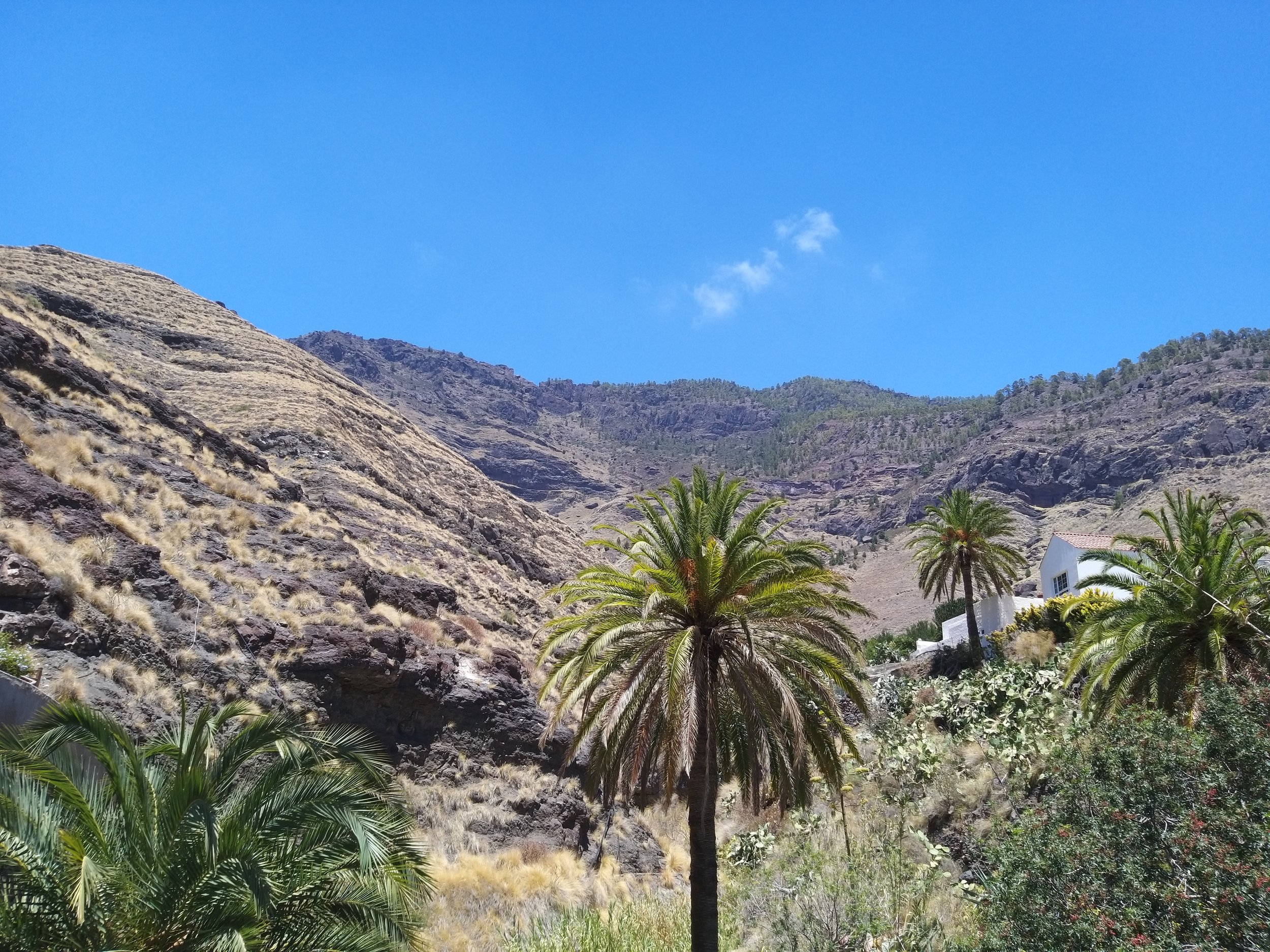The wild West
After the north, this time we wanted to explore the west of the island—starting where we left off yesterday—in Puerto de las Nieves.
This place lies beautifully by the sea with its white and bluewashed houses, flanked by rugged hills. A pebble beach invites you to swim and is never crowded.
At most, a few locals—especially children—play in the water. On the beachfront promenade, fish restaurant after fish restaurant line up. Almost all have terraces with a sea view. The restaurants are simple—you shouldn’t expect any frills—but the fish and seafood come straight from the sea, and the vegetables are grown locally. We’ve never been disappointed by the food here.
In the past, you could admire the “Dedo de Dios” (Finger of God) rock from the pier in the harbour—this rock has since been lost to a storm many years ago; only a plaque remains to remind of it.
A few kilometers behind Puerto de las Nieves lies Agaete, also surrounded by steep cliffs but with much greenery. In the botanical garden, you can admire rare plants.
Particularly worth seeing is the Iglesia de la Concepción, and the pretty lanes of the centre are also worth a visit.
The valley of Agaete—Valle de Agaete—is the most agriculturally significant centre in the area. Here, vegetables and fruit are grown—and even tropical varieties and coffee plantations.
As passionate coffee lovers, we naturally wanted to visit one of these coffee plantations. So we drove to the small village of San Pedro, idyllically situated in the green valley.
The white houses of this sleepy village form a dreamy contrast to the green hills and blue sky. With its winding alleys, the village looks like something out of a fairy tale.
Not far from San Pedro is the plantation, nestled in the valley amid lush green hills. There, you learn all about the cultivation and processing of coffee beans.
At the café/shop attached, you can practise roasting the beans yourself and sample various varieties—a highlight for us.
In the shop, we also bought some varieties of this wonderful drink.
Then we drove on to El Risco. Along the way, we enjoyed a wonderful view of Puerto de las Nieves. The road wound ever upward via hairpin bends along steep cliffs.
From that small, pretty hamlet, a hiking trail leads to Charco Azul—a gorge with a waterfall tumbling into a small pool.
The trail led through lush meadows with vistas of the cliffs. This part of the island is by far the most rugged and mountainous of the entire coast.
In winter, the waterfall and lake are surely spectacular; in summer it was more of a trickle from the rocks. The pool was narrow, relatively shallow and inhabited by numerous frogs.
The water was refreshingly cool. We had the entire place to ourselves. The hot air, cool water, romantic surroundings—all that made us almost forget time.
Still, we soon had to move on, and our hunger was also growing.
We retraced the same path back to El Risco and looked around the small village a bit more.
Our next stop was Playa de Aldea, one of the few larger beaches on this coast. A strong wind blows constantly here, the beach is made of pebbles and the sea has high waves. In such an environment, I immediately felt right at home.
First, we found a cosy little restaurant with a wonderful sea view. We ordered crisp salad, juicy calamari, freshly grilled sardines and hearty red wine.
The food tasted wonderful, the atmosphere was idyllic.
Well fed, we took a long walk along the promenade. In the small harbour, boats rocked on the water. In the shops, besides the usual souvenirs, you could find everything needed for a successful day at the beach.
Behind us rose majestic mountains high into the sky. It was a picture‑book landscape.
Of course, we also wanted to enjoy the cool water. We found a nice spot on the beach. It wasn’t easy to spread our towels because the strong wind kept threatening to blow them away.
The water was wonderfully refreshing, and the high waves made swimming truly interesting. I love it when the sea is turbulent and I have to fight against the waves. Only then do I feel truly alive.
We spent several hours at this beautiful spot before it was time to move on.
The road—via numerous hairpin bends—now led ever farther south. We passed some lovely villages and even saw an old windmill.
Finally, we reached the turn‑off to Playa de Tasarte, a small fishing village on the coast.
There are only a few houses in this tiny settlement, which can only be reached via a gravel track. The beach is made of coarse pebbles.
At the end of the beach, there’s a wonderful fish restaurant. We wanted to eat dinner there. We snagged a table in the front row by the beach.
Again, there were freshly caught sardines, a colourful ensalada mixta and papas arrugadas with mojo as a side that completed the feast.
While we ate, we watched the innkeeper climb into his boat to catch more fish and seafood.
By the time we finished eating, the sun was already very low. Since we didn’t want to drive the narrow switchbacks in the dark, we reluctantly left this wonderful place.
Along the way we experienced a surprise—where once you had to drive many hairpin bends, there is now a tunnel. This shortened the return journey to San Agustín by almost an hour.


































